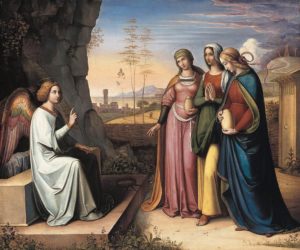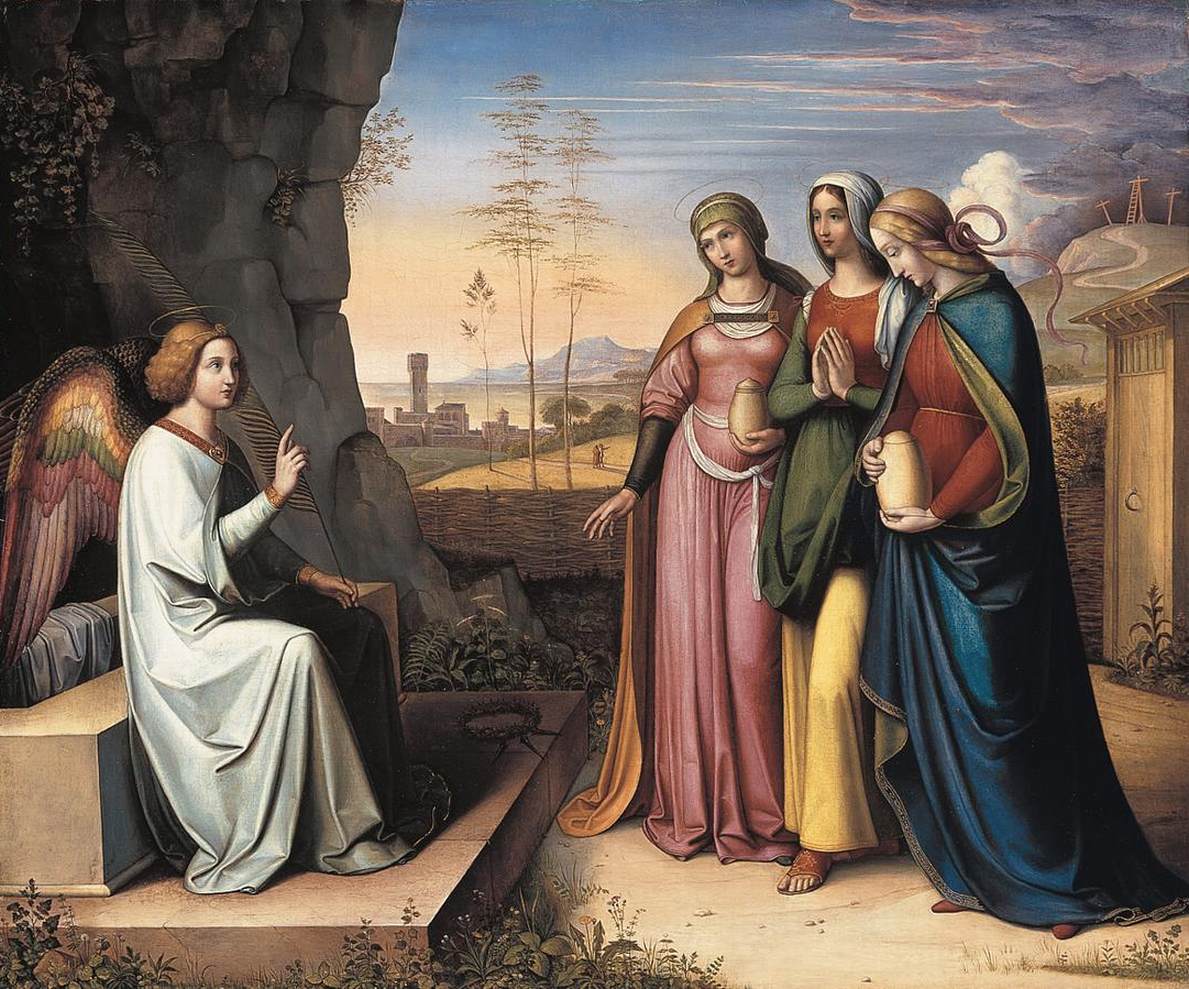
Nearly all of the resurrection accounts in the Gospels present the apostles and disciples on a journey to deeper faith. In stages they come out of this world and the darkness of despair into the light of faith. Matthew’s account, which is read at the Easter Vigil and can also be read at Masses during the day, is no exception.
Let’s look at the Easter journey that Mary Magdalene and Mary (likely, Mary the Mother of James and Joses) make out of darkness into light. Mark’s Gospel account adds that Salome (the wife of Zebedee and the mother of James and John) went with them. Luke’s Gospel account has Joanna (wife of Herod’s steward, Chusa) accompanying them as well. Hence, even though Matthew only mentions Mary Magdalene and Mary by name, it would seem that there were four women. As the women journey through the events of Easter morning we see their faith deepen and brighten. In a condensed sort of way, we also see the whole life of the Christian, who in stages comes to deeper faith and a brighter vision of the paschal mystery that is our life.
Let’s observe their journey in four stages.
Disturbance at Dawn
After the Sabbath, as the first day of the week was dawning, Mary Magdalene and the other Mary came to see the tomb. And behold, there was a great earthquake; for an angel of the Lord descended from heaven, approached, rolled back the stone, and sat upon it. His appearance was like lightning and his clothing was white as snow. The guards were shaken with fear of him and became like dead men.
In this first stage it is still quite dark. The text here notes, with hope, that the new day was dawning. The Greek word that is translated as “dawning” more properly means “approached,” or “drew on,” without specifying the time so closely. In Mark’s account he notes that it was very early in the morning, at the rising of the sun. In other words, the sun was not already risen but about to rise. Luke notes that it was “very early in the morning” (the Greek text indicates that it was “deep twilight” or when there was scarcely any light). John’s Gospel says that it was “very early, while it was yet dark.”
The point is that it is still quite dark but dawn is near. This creates for us readers an air of great expectation. An old song by the Taizé community says, “Within our darkest night, you kindle a fire that never dies away.”
Next, there is a great earthquake. Sometimes God has to shake things up to open new doors and new vision. In our life, too, there are often violent shakings, but remember that in just a few short years we’ll be with God if we are faithful. So it is that this earthquake is not unto destruction but is unto the opening of the tomb that has claimed our Lord and unto the opening of tombs that have claimed us emotionally, spiritually, and mentally. This earthquake, frightening though it may seem, serves only to draw these women deeper into the paschal mystery and toward the risen Christ.
Note that they have yet to see Him or even hear that He is risen. For now, there is only this earthquake, but it has a purpose. Now it is barely dawn and things are still very unclear to them.
Declaration: Do Not Be Afraid
Then the angel said to the women in reply, “Do not be afraid! I know that you are seeking Jesus the crucified. He is not here, for he has been raised just as he said. Come and see the place where he lay.
Note that the angel summons them to deeper faith. He exclaims, “Do not be afraid.” To many of us this may seem like a throwaway line, one we often hear when others perceive us to be as anxious. Sometimes when others say this to us it can be both annoying and unhelpful. In this case, though, the angel presents a basis on which their faith should grow and their anxiety dissipate.
That they should not be anxious or afraid is rooted in the Lord’s promise and in His word. The angel is reminding them that the Lord promised to rise on the third day and that He has done just that. The Lord, who has raised others from death and healed multitudes, has done exactly what He promised.
Hence, the angel summons them to grow in their faith by pondering the Word of Jesus Christ and coming to trust in His promise.
The angel also presents evidence to them—the evidence of the empty tomb. He invites them to connect the dots between Jesus’ promise and the empty tomb before their eyes.
It’s getting brighter, by the power of God’s Word and its application to the present situation.
We, too, must journey through this stage as we become more deeply immersed in God’s Word and apply it to our circumstances. As we grow in knowledge and remembrance of God’s promises and His word, our anxiety begins to dissipate. This happens especially when God helps us to connect His word to what is actually happening in our life. We start to notice the empty tombs, the many signs of God’s favor and blessing. Things start to add up and we begin to connect the dots between faith and experience. As we do this it gets brighter and our faith grows stronger.
Deepening Dispatch
Then go quickly and tell his disciples, ‘He has been raised from the dead, and he is going before you to Galilee; there you will see him.’ Behold, I have told you.”
Learn by teaching – Having been instructed in the paschal mystery and grown deeper in their faith, they are sent by the Lord to inform others. An interesting side effect of teaching is that we often learn more by teaching than we learned as a student. We grow in our faith as we begin to teach and testify to it. The acts of teaching and witnessing cause us to grow.
Note that the text says, Behold, I have told you. True faith is received from God; we do not invent it. St. Paul says, “Faith comes by hearing.” Do not go out and invent your own faith; that would be a very bad idea! We receive the faith from God through the Church and the Scriptures approved by the Church. These women have first been instructed by God’s angel. Only after that are they told to go and tell others. We too are instructed by the Church. Our faith comes from what we hear, and we pass that on.
So, these women are sent. As they go they have a great breakthrough, but prior to that breakthrough, they are sent to witness, to proclaim. This very act deepens faith even more.
The Discovery that is Definitive
Then they went away quickly from the tomb, fearful yet overjoyed, and ran to announce this to his disciples. And behold, Jesus met them on their way and greeted them. They approached, embraced his feet, and did him homage. Then Jesus said to them, “Do not be afraid. Go tell my brothers to go to Galilee, and there they will see me.”
This final stage is an important and powerful one. Unfortunately, too many Christians ignore it. In this moment they go from inference to experience. Up until this point their “knowledge” was based only on what others said, but now they know from experience. They can now personally vouch for the truth of what they proclaim. Inference is a necessary stage of our faith, but the Lord invites us deeper to more personally experience the truth of what the Church has always proclaimed and what her Scriptures have always announced.
These women heard from the angel that Jesus is risen, and they receive the teaching with joy, but on the way, on the road of their life, they come to personally meet the risen Lord Jesus Christ. Suddenly the truth of what they have been taught is made personal to them and experience it as real. They have gone from inference to experience. From now on they will tell not only what they have heard from others but also how they have personally experienced it as true.
We are invited to do the same. Each of us needs to be able to say, “In the laboratory of my life I have come to personally experience as true all that the Church and her Scriptures proclaim. I am a firsthand witness to Jesus, for I have experienced Him personally in my life. I have met Him in my prayer and in my experience. He is alive and real to me, and He is changing my life. I have done more than hear about the Lord; I have met Him. I do not merely know about Him, I know Him.”
Do you know the Lord, or do you just know about Him? Have you met Him or have you just heard about Him? On this Easter Sunday morning we have observed a group of women go from the darkness of this world to the light of the normal Christian life. What is the normal Christian life? It is being in living, conscious contact with God and personally knowing the Lord of all glory. It is being in a living and transformative relationship with the Lord Jesus Christ.


Thank you Monsignor and may you and your kitten gave a joyous Easter. Thank you for teaching us
during our Lenten journey…
“It is being in living, conscious contact with God and personally knowing the Lord of all glory. It is being in a living and transformative relationship with the Lord Jesus Christ.” Our brothers in faith from Protestantism boast of ‘personal relationship’ with Our LORD JESUS CHRIST. Your version of ‘living and transformative relationship’ describe a much deeper relationship. For it is precisely what transpired when I encountered The LORD and is continually transpiring in my walk with The LORD. The Scriptures, The Holy MASS, the Church and the people of GOD and HIS Grace and Blessings, and even pains and sufferings, they all lead me to a ‘living and transformative relationship’ with the MAN-GOD Who gave all, even HIS Life for me, for us. In this last Holy Triduum, Monsignor, through your in-depth reflections, we were led into an even deeper transformative encounter with HIM, together with the Church’s Traditional solemn commemoration and teachings. It’s as though we had eagle’s eyes that can see even from great heights the details of a terrain and at the same time microscopes that can zoom in the minutest feature of miniscule grain of understanding the Life of JESUS in the salvation history for man. Yes, that is ‘living and transformative relationship!’ YHWH SHEKINAH
The majority of Bible scholars do not believe that eyewitnesses or the associates of eyewitnesses wrote the Gospels. The only people who still believe that they were are evangelicals and fundamentalist Protestants. If the Gospels are not eyewitness testimony, then the stories within them are nothing but hearsay. Is that really sufficient evidence to believe that a first century brain-dead corpse came back to life, exited its sealed tomb, and later flew off into the clouds?